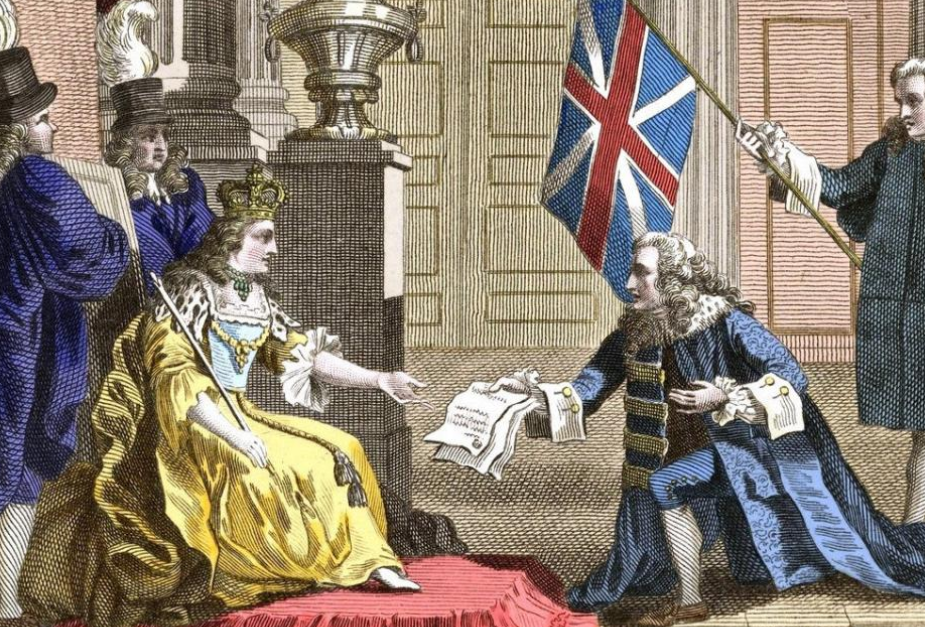Scotland and the British Empire
Scotland and the British Empire
How British imperial projects saved Scotland from economic ruin, 1707-1945
(1707 Union of the Crowns. Source: British Library)
[The following essay was written for Professor Mikki Brock’s “History of Scotland” course in Fall 2023. Footnotes are included at the bottom of the article.]
The sun never sets on the British Empire, or at least it didn’t until well into the twentieth century. Simultaneously during this imperial period, Scottish calls for independence from England ceased. The Jacobite’s last challenge to the crown failed in 1745, and for two centuries to follow, Scotland disproportionately supported British imperialism. Scottish soldiers and merchants sailed across the world for their motherland, while domestic Scots industrialized and urbanized to support an imperial economy. Although not every Scot benefited greatly from this union, the promise of opportunity coupled against the fear of economic stagnation sustained British unity until the events accompanying the Second World War unraveled imperial control.
Prior to the Act of Union in 1707, England had prohibited Scottish merchants from trading directly with the crown’s transatlantic colonies. While smugglers could circumvent this law without much difficulty, the worsening conditions of Scotland’s economy at the turn of the century had forced the Scots to concede their parliamentary independence in exchange for further trade guarantees with England. Scottish merchants could now sail to the West Indies and beyond, protected by the British flag and the Royal Navy.[1] While Scottish slave ports had a relatively small direct impact on the average Scot, their country depended on the enslaved laborers who harvested tobacco, sugar, and indigo, to name a few. Scotland not only depended on these products, they drove the imperial economy with them: by the 1770s, “the Scots were reckoned to control over half the trade in the key areas of new colonial tobacco production in the Chesapeake.”[2]
While the slave trade had ended by the Victorian Era, Scotland’s global market had not. The Scots industrialized with railways, pursued new careers in banking, and diversified their overseas investments in Asia, Africa, Europe, the United States and Latin America.[3] Scottish elites were overrepresented in the British officer class and often administered colonies that had been annexed through war. These civil offices were frequently inherited by the nobleman’s eldest son, while the remaining siblings would have to seek alternative careers and patronage throughout the empire.[4]
Rich or poor, the military offered opportunities to every Scotsman. Highland valor was recognized internationally, and as such became an archetypal image within the British Army: even Scottish regiments that enlisted outside the Highlands wore tartan. Scots had fought for empire throughout the Victorian Era, and by the First World War, “Scots signed up to fight more readily than did the English, Welsh, or Irish.”[5] Scots did not consider abandoning the British union in 1914, and they certainly did not when erecting a memorial to their deceased Scottish brethren—both at home and around the world—a few years later.[6]
Battlefield casualties were not the only consequence that the Scots endured during their union with the British Empire. While the industrial boom in Scotland nourished an imperial economy, it left the urban workers in less-than-ideal circumstances. These conditions would only worsen amid the post-war decline predating the Great Depression. Even in the mid-nineteenth century, industrial cities like Glasgow faced severe overcrowding: Glasgow had tripled its population to nearly 300,000 within three decades. Once wealthy neighborhoods that housed tobacco merchants filled with immigrants and displaced farmers who were willing to work and live in dismal conditions. A series of failed policing reforms ultimately introduced a program to demolish many of the slums and to remove its “parasitic” tenants.[7] Workers lived in similar conditions for decades to follow, as demands for reform championed by the Labour Party only gained political traction in the 1920s. During the previous decade, Scottish industrial production had focused on war supplies, which made interwar unemployment rates skyrocket in comparison to the rest of Britain.
Although the Scottish National Party formed in 1934, it remained a fringe group whose mission of independence from Britain lacked substantial support among the working class. Even though conditions in the cities were not adequate for everyone, the entire reason people immigrated there was because of the job opportunity it might afford. If Scotland renounced their affiliation with British trade, they would lose their British-dependent industry and trade privileges. For those workers loyal to the Empire, it seemed only a matter of time before production would pick up again and allow the workers to reap the benefits of union.
The consequences of disunion remained just as fixed in Scottish collective memory as the benefits of union did. Before the Act of Union in 1707, Scotland had attempted to develop an imperial presence independently. But the Darien Scheme of the late-seventeenth century had served only to bankrupt Scottish elites and emphasize their inability to develop alone. The Scottish economy needed the British state as much as it needed Scotland. Not until this imperial dynamic fractured in the wake of the Second World War could calls for Scottish independence grow. Calls have continued to grow since—especially within the last decade—though unionists still fear the economic repercussions that might accompany an independent nation.
NOTES:
T.M. Devine, “Introduction: Scotland and Transatlantic Slavery,” Recovering Scotland’s Slavery Past: The Caribbean Connection (Edinburgh: Edinburgh University Press, 2015), 12-13.
T.M. Devine, “Did Slavery make Scotia Great? A Question Revisited,” Recovering Scotland’s Slavery Past, 227.
T.M. Devine, “Lost to History,” Recovering Scotland’s Slavery Past, 32.
Devine, “Introduction: Scotland and Transatlantic Slavery,” 15-16. See also, Esther Breitenbach, “The Impact of the Victorian Empire,” 10-11. Scots made up 1/3 of the colonial Governors General between 1850 and 1939.
Esther Breitenbach, “The Impact of the Victorian Empire,” The Oxford Handbook of Modern Scottish History, ed. T.M. Devine and Jenny Wormald (2012), 8-9.
Jenny Macleod, “‘By Scottish Hands, with Scottish Money, on Scottish Soil’: The Scottish National War Memorial and National Identity,” Journal of British Studies 49, no. 1 (2010): 73–96, http://www.jstor.org/stable/27752691. Even though the memorial had a distinctly Scottish emphasis, it memorialized Scots who lived across the British Empire. This “imagined community,” as Macleod calls it, reveals the multifaceted nature of Scottish identity, which is bound up in both a strong tradition of independence but also an expressly imperial one reliant on Britain.
“The Context of Thomas Annan’s Photographs of ‘Old’ Glasgow,” National Galleries of Scotland, accessed November 21, 2023, https://www.nationalgalleries.org/art-and-artists/features/thomas-annan.


